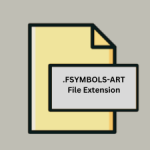.VPE File Extension

Photoshop Vanishing Point Export File
| Developer | Adobe Systems |
| Popularity | |
| Category | Raster Image Files |
| Format | .VPE |
| Cross Platform | Update Soon |
What is an VPE file?
The .VPE file extension is associated with Adobe Photoshop and specifically relates to the Vanishing Point feature.
This feature allows users to define perspective planes in images, facilitating accurate placement of 2D content within a 3D space.
The .VPE file serves as an export format for these defined planes, preserving spatial information crucial for further editing or integration into 3D rendering applications.
More Information.
Upon its debut in Photoshop CS2, Vanishing Point revolutionized how designers and artists worked with perspective in digital images.
Prior to this feature, achieving accurate perspective transformations required meticulous manual adjustments.
The .VPE file format was designed to streamline this process by encapsulating perspective plane definitions in a portable format, ensuring consistency across editing sessions and enabling seamless integration into Adobe’s broader creative ecosystem.
Origin Of This File.
Adobe introduced the Vanishing Point feature in Photoshop CS2, aiming to simplify the process of editing and compositing images with perspective.
The .VPE file format emerged as a means to store the geometric data of perspective planes defined within the Vanishing Point grid.
This capability greatly enhances the precision of placing graphics, textures, or other elements onto surfaces within a perspective-correct environment.
File Structure Technical Specification.
The .VPE file is typically structured to include metadata and geometric data describing the perspective planes defined within Photoshop’s Vanishing Point grid. Key technical specifications include:
- Metadata: Information about the image dimensions, color space, and other relevant parameters.
- Plane Definitions: Coordinates and transformations that define the perspective planes within the image.
- Compatibility: The .VPE format is designed to be compatible with various versions of Adobe Photoshop and can be imported into compatible 3D rendering software for further manipulation.
How to Convert the File?
Converting .VPE files may not be straightforward due to their specialized nature. However, users can export perspective data in alternative formats supported by Photoshop, such as PSD (Photoshop Document), which retains layer and transformation information.
Conversion tools or scripts may also be developed to translate .VPE data into other formats compatible with different software applications.
Advantages And Disadvantages.
Advantages:
- Precision: Enables precise alignment of 2D elements in 3D space, crucial for realistic compositing.
- Workflow Efficiency: Reduces manual effort in perspective correction and integration tasks.
- Integration: Seamless compatibility with Adobe Photoshop and other creative software.
Disadvantages:
- Complexity: Understanding and mastering the Vanishing Point feature and .VPE files can require significant learning and practice.
- Dependency: Proper utilization requires Adobe Photoshop or compatible software, limiting accessibility for users without access to these tools.
How to Open VPE?
Open In Windows
- Install Adobe Photoshop or the Adobe Creative Suite that includes Photoshop.
- Double-click on the .VPE file, and it should open in Photoshop if it is the default application for handling such files.
Open In Linux
- Adobe Photoshop is not officially supported on Linux, but you may explore compatibility through virtual machines or alternative software solutions that can read XML-based files.
Open In MAC
- Similarly, install Adobe Photoshop through Adobe Creative Cloud.
- Double-click on the .VPE file, and it will launch in Photoshop.













